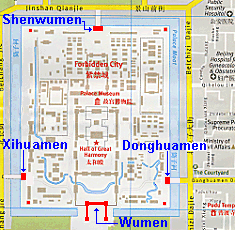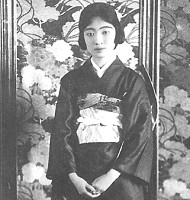The Exhibition Hall of Antiques


The picture above displays a large sign above the main entrance announcing that this is the "Office of the Hall" and here's why:
When China's last emperor, Pu Yi, abdicated in 1911 and the Republic was founded in 1912, the treasures of the Imperial Household were collected from Shenyang and Chengde and put on display in the newly established Exhibition Hall of Antiques in the outer court south of Qianqingmen.
The official office of this hall was set up inside Xihuamen and access to the exhibition was only through this gate.
Moreover, in 1915 an opening was made in the northern part of Zhongshan park and a large, wooden bridge built leading from the park to Xihuamen to make it even easier for visitors to get to Xihuamen and the exhibition inside the Palace City.


Xihuamen is a five bay (yeng) building with three entrances and doubled eave Xieshan roof covered with yellow glazed tiles. The central doorway was larger than its sister entrances and it was, as always, for the exclusive use by the emperor.
Despite being obvious, few notice that the doorways of the gates only are arched on the side facing the Palace City, whereas they are rectangular or square on the outside.
Note the white marble balcony which adorns the top of the platform except for a section in the front.
Like all its sister gates into the Palace City, Xihuamen was equipped with horse ramps on the inside, leading to the top of the wall.
Note on the 1922 picture above how the dating verifies itself with the car models on the right and the rickshaws on the left. Both the driver (right front) and the rickshaw drawer (barely visible left -leaning against the fence) are waiting for a fare.

Xihuamen viewed from Wumen
The gate hasn't changed much in the 92 years between the two pictures; in fact, the road, the street lights and the way people dress have changed a whole lot more than the gate itself!
Many of the important ceremonies held in Ming dynasty times (1368-1644) were processed through this gate.
Connecting the Outer Court of the Palace city with access to the capital across the moat, this gate was used extensively to ferry supplies into the palace as well as removing waste and garbage from the palace. Just like its sister gate at the east, Donghuamen, this gate was very much a "working" gate, carrying all the daily business traffic.
But it wasn′t all business. On the occasions when the emperor and empress with entourage visited the lakes and gardens west of the palace they would enter and exit through this gate.






